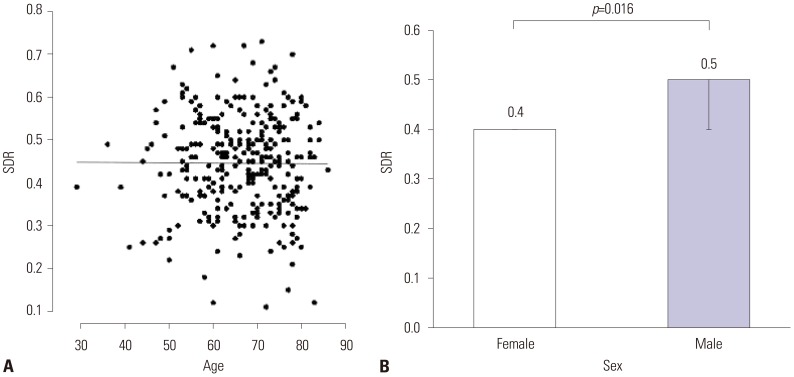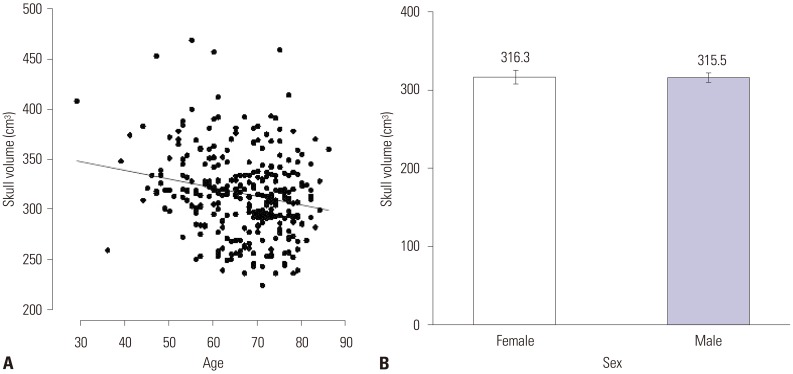Yonsei Med J.
2019 Aug;60(8):768-773. 10.3349/ymj.2019.60.8.768.
Skull Factors Affecting Outcomes of Magnetic Resonance-Guided Focused Ultrasound for Patients with Essential Tremor
- Affiliations
-
- 1Department of Neurosurgery, Brain Research Institute, Yonsei University College of Medicine, Seoul, Korea. jchang@yuhs.ac
- 2Department of Neurosurgery, Brain Research Institute, Chung-Ang University College of Medicine, Seoul, Korea.
- KMID: 2452958
- DOI: http://doi.org/10.3349/ymj.2019.60.8.768
Abstract
- PURPOSE
Magnetic resonance-guided focused ultrasound (MRgFUS) thalamotomy has become a standard treatment for medically intractable essential tremor (ET). Skull density ratio (SDR) and skull volume in patients with ET are currently considered useful indicators of the successful application of MRgFUS. We compared the clinical outcomes of MRgFUS thalamotomy with SDR above 0.4 and 0.45. We also described patterns of SDR and skull volume in Korean patients with ET who were eligible to be screened for MRgFUS.
MATERIALS AND METHODS
In screening 318 ET patients, we evaluated patterns of skull density and skull volume according to age and sex. Fifty patients with ET were treated with MRgFUS. We investigated the effects of SDR and skull volume on treatment parameters and the outcomes of ET.
RESULTS
The mean SDR of the 318 ET patients was 0.45±0.11, and that for skull volume was 315.74±40.95 cm³. The male patients had a higher SDR than female patients (p=0.047). Skull volume significantly decreased with aging. SDR and skull volume exhibited a linear negative relationship. Among therapeutic parameters, maximal temperature was positively related to SDR, while sonication number was not related to either SDR or skull volume. Tremor outcome was also not related to SDR or skull volume.
CONCLUSION
SDR varied widely from 0.11 to 0.73, and men had a higher SDR. Therapeutic parameters and clinical outcomes were not affected by SDR or skull volume.
Keyword
MeSH Terms
Figure
Reference
-
1. Prada F, Kalani MYS, Yagmurlu K, Norat P, Del Bene M, DiMeco F, et al. Applications of focused ultrasound in cerebrovascular diseases and brain tumors. Neurotherapeutics. 2019; 16:67–87. PMID: 30406382.
Article2. Jolesz FA, Hynynen K. Magnetic resonance image-guided focused ultrasound surgery. Cancer J. 2002; 8(Suppl 1):S100–S112. PMID: 12075696.3. Connor CW, Hynynen K. Patterns of thermal deposition in the skull during transcranial focused ultrasound surgery. IEEE Trans Biomed Eng. 2004; 51:1693–1706. PMID: 15490817.
Article4. Chang WS, Jung HH, Zadicario E, Rachmilevitch I, Tlusty T, Vitek S, et al. Factors associated with successful magnetic resonance-guided focused ultrasound treatment: efficiency of acoustic energy delivery through the skull. J Neurosurg. 2016; 124:411–416. PMID: 26361280.
Article5. Elias WJ, Lipsman N, Ondo WG, Ghanouni P, Kim YG, Lee W, et al. A randomized trial of focused ultrasound thalamotomy for essential tremor. N Engl J Med. 2016; 375:730–739. PMID: 27557301.
Article6. Chang JW, Park CK, Lipsman N, Schwartz ML, Ghanouni P, Henderson JM, et al. A prospective trial of magnetic resonance-guided focused ultrasound thalamotomy for essential tremor: results at the 2-year follow-up. Ann Neurol. 2018; 83:107–114. PMID: 29265546.
Article7. Elias WJ, Huss D, Voss T, Loomba J, Khaled M, Zadicario E, et al. A pilot study of focused ultrasound thalamotomy for essential tremor. N Engl J Med. 2013; 369:640–648. PMID: 23944301.
Article8. Alswat KA. Gender disparities in osteoporosis. J Clin Med Res. 2017; 9:382–387. PMID: 28392857.
Article9. Schwartz ML, Yeung R, Huang Y, Lipsman N, Krishna V, Jain JD, et al. Skull bone marrow injury caused by MR-guided focused ultrasound for cerebral functional procedures. J Neurosurg. 2018; 4. 01. [Epub]. DOI: 10.3171/2017.11.JNS17968.
Article10. Jung NY, Rachmilevitch I, Sibiger O, Amar T, Zadicario E, Chang JW. Factors related to successful energy transmission of focused ultrasound through a skull: a study in human cadavers and its comparison with clinical experiences. J Korean Neurosurg Soc. 2019; 5. 30. [Epub]. DOI: 10.3340/jkns.2018.0226.
- Full Text Links
- Actions
-
Cited
- CITED
-
- Close
- Share
- Similar articles
-
- Magnetic Resonance-Guided Focused Ultrasound in Neurosurgery: Taking Lessons from the Past to Inform the Future
- Magnetic Resonance-Guided Focused Ultrasound : Current Status and Future Perspectives in Thermal Ablation and Blood-Brain Barrier Opening
- Factors Related to Successful Energy Transmission of Focused Ultrasound through a Skull: A Study in Human Cadavers and Its Comparison with Clinical Experiences
- Ultrasonography and Ultrasound-guided Interventions of the Shoulder
- Pregnancy and Natural Delivery Following Magnetic Resonance Imaging-Guided Focused Ultrasound Surgery of Uterine Myomas




